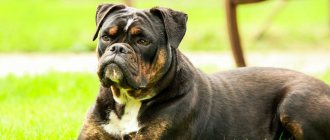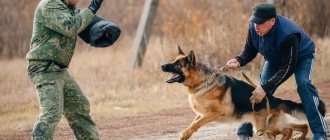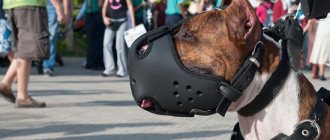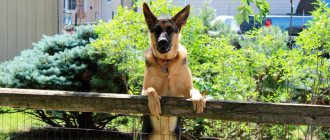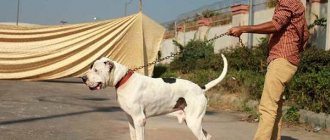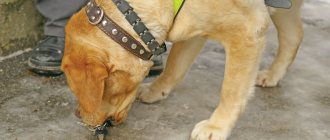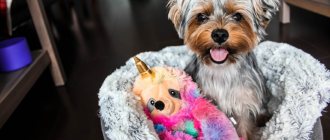Origin
The origin of this variety of bulldog is attributed to Pakistan, which is not far from the truth. The first mentions of gul dong at the end of the 19th century referred to the territory of this country. However, technically, the territory of modern Pakistan was considered an Indian colony, which means it makes sense to say that the origin of the dog has Indian roots.
It is difficult to find out the exact history of the origin and selection of fighting bulldogs due to the narrowness of their distribution area. Gul dong can be found in Pakistan, India, Iraq and Afghanistan. The ancestors of the Gul Dong are considered to be the Pakistani Mastiff (Bully Kuta) and the Pakistani Fighting Terrier (Gul Terrier). A number of sources mention the Dogo Argentino, the Old English Bulldog and the Bull Terrier. The selection principle was characterized by four main cherished qualities: power, speed, agility and aggressiveness. The breed has not received recognition from cynological associations around the world.
History of the breed
To create the Gul Donga, two local breeds were crossed: the Gul Terrier and the Bully Kutta. The result is a dog that combines the size and power of a bully cutt with the agility and swiftness of a ghoul terrier. The dog is medium in size, larger than the Ghoul Terrier, but more compact than the Bully Cutta.
However, this is nothing more than an assumption, since nothing is known for sure about the history of the breed. It is believed that she comes from the colonial part of India, which was ceded to Pakistan in 1947.
This breed is not affiliated with any international canine organization or club, and there are no stud books or standards.
Gul Terrier, Bully Kutta and Gul Dong are guard, guard, fighting and hunting dogs. Despite the fact that dog fighting is prohibited in many countries, including Pakistan, it is widely held illegally, and there are even championships.
Most of the blood of these dogs belongs to English dogs that came to India and Pakistan during colonial rule. Among them is a bull terrier, which was bred to participate in dog fighting.
These dog traits were passed on to the Gul Dong, through the Gul Terrier and the Bully Kutta. Ghoul Terriers appeared in India and Pakistan in the 1900s, no doubt from the Old English Bulldog. Some believe that this is the Old English Bulldog, preserved in Pakistan.
Others say that it was crossed with native breeds, better adapted to the hot climate of the country. You can read about the origin of Bulli Kutta at this link.
In Pakistan, Afghanistan, and India, these dogs are kept as guards and guards. In addition, they hunt large game and participate in dog fights.
Dimensions, appearance
Cynological associations do not recognize the existence of such a breed as the guldog. Therefore, there is no point in talking about breed standards. The selection of individuals for mating is carried out according to the same four parameters: power, speed, agility, aggressiveness.
An adult male reaches 70-80 cm at the withers, a female's height is 60-70 cm. The tallest recorded height of a ghoul dog is 116 cm. The weight of an adult dog ranges from 35 to 60 kg. Sources call the specimen weighing more than 95 kg the most massive dog of the breed. The body structure of females and males does not differ significantly.
Body structure
The body is proportional with pronounced muscles.
Powerful long neck, large head, sometimes seeming disproportionately large in relation to the body.
The Pakistani has a long tail, which is docked for puppies intended for fighting. Even the undocked tail of the Gul Dong does not rise high.
The coat is short and harsh. The color is varied (white, black, red, gray, solid, with stripes or spots). The most popular dogs are those with light coats. The short, hard coat lies closely to the skin.
The paws are long, powerful, without curvature.
Muzzle
Broad forehead. The transition from the forehead to the muzzle is small and weakly expressed. The mouth has folds of skin. Ears are floppy from birth. Most representatives of the breed have their ears cropped during puppyhood. Cropped ears stand upright.
The almond-shaped dark eyes are distinguished by a wide set on a short muzzle with a rounded nose, often fully pigmented or in small spots.
The jaw muscles are highly developed. The jaw bones are powerful, massive with large, strong fangs. When closed, they form a correct scissor grip.
Character traits
The Pakistani bulldog is distinguished not only by its intelligence, cunning, stubbornness, but also by its devotion to its owner and his family. This fact does not diminish the danger of the breed to others. Gul dogs are dominant dogs with increased aggressiveness that require specific training by an experienced dog handler.
As soon as the owner of the Pakistani dog gives up the dominant position of the “leader of the pack” a little, the dog will not hesitate to show aggression and attack the “weakened leader.” The appearance of a stranger on the territory of the gul dong, noise, bustle, other animals and any other irritants will provoke an immediate attack.
Pakistanis are not adapted to urban conditions and living in an apartment. Temperamental dogs are constantly looking for a point of application of boiling energy, because, deprived of fighting practices, they remain excellent watchmen and security guards. Gul dong is suitable for keeping in an enclosure in a village or small settlement with a large local area. In any case, representatives of the breed need to exercise a lot during the day. Walking a gul donga is not a leisurely walk, but a jog at a good pace or a bicycle cross.
Character
A fighting dog like the Gul Dong is not a family friendly breed. It is not suitable for families with children. Such a dog must feel the superiority of the owner and all members of his family. If there are children or elderly people in the family, you should not leave the dog alone with them.
If a bulldog is raised correctly, it can become a good watchdog. However, you always have to be on your guard with him, as he can attack unexpectedly. And it is most likely beyond the power of any person to cope with such a huge, powerful dog.
As has already become clear, they cannot have any relationship with their children. You shouldn't even let your dog get close to children. Otherwise, if the dog doesn’t like something, it may simply bite the person to death.
These dogs have the same story with other pets. No animals can get along with him in the same territory, he is aggressive towards everyone and is a terrible owner. Gul Dong is even aggressive towards animals outside the house, so he must be walked by a person who can hold him. Don't forget that he is one of the most dangerous dogs in the world.
Training
Two important points of training are dominance and socialization. Gul Dong puppies raised in isolation from people and other animals are as aggressive as possible. Socialization should begin at a very early age and continue throughout the dog's life.
Wayward Pakistanis occupy dominant positions in the dog hierarchy. This must be taken into account by the owner, who will have to train himself, because the owner must literally suppress the will of the dog.
A beginner in the field of cynology and training risks his life and health by acquiring a representative of the gul dongs. The most insignificant nuance in relations with an animal or the slightest indulgence can cause a loss of authority in the eyes of a Pakistani and provoke an instant attack.
For example, when walking, a Pakistani bulldog should always be at least one step behind its owner. From puppyhood, the dog must be constantly monitored and in contact with it, in order to avoid the same loss of authority.
Maintenance and care
Gul dongs are unpretentious in maintenance and require only a minimum of sanitary procedures. It is necessary to wash the dog completely no more than 1-2 times a year. Short hair does not need a hair dryer; exposure to a stream of warm air can even cause drying of the skin.
Grooming involves combing with a thick rubberized glove in the direction of hair growth up to 2 times a week.
Cleaning the eyes with a cotton pad soaked in warm water is done as needed.
Once a week it is necessary to treat the ears of a Pakistani bulldog with a cotton pad soaked in hydrogen peroxide.
Claws should be trimmed with special pliers once every two weeks to a month.
Cleaning with a special fingertip and toothpaste every 3 days will help prevent problems with teeth and the appearance of plaque.
Health
Due to its vicious nature, this breed is often used as a fighting dog. Then her ears and tail are cropped. Due to heavy physical exertion, such animals do not live longer than 7 years.
If the dog lives on the street, you should carefully ensure that the box is dry, with tightly fitted boards. They do not tolerate drafts well. Most often this ends in otitis media for them. Accustomed to high temperatures. But frosty winters are bad for them due to their short fur.
Very rarely they have genetic abnormalities. Anomalies in skeletal development are associated with a poorly selected diet and lack of nutrients.
The problem for these dogs is the appearance of tartar and unpleasant odor from the mouth . To avoid this, teach your puppy to brush his teeth once every two to three days from the age of two months. Then, having matured, he will perceive this procedure calmly. In addition, toys are needed that will help get rid of tartar.
Nutrition
Keeping a Gul Dong dog is not cheap. The powerful muscular frame of the Pakistani needs constant replenishment with protein. When purchasing a dog, you need to make a choice in favor of natural food or dry food, and not mix these food lines in the future.
Natural food
The Pakistani Bulldog eats about 3 kg of meat during the day. The basis of the diet is:
- Lean meat and fish;
- Giblets;
- Broths based on meat and fish, soups based on them;
- Porridge to provide the body with fiber;
- Fermented milk products: cottage cheese, kefir, yogurt;
- Fresh vegetables to maintain vitamin balance.
Dogs are prohibited:
- Fat meat;
- Bones;
- Bread products;
- Legumes, corn, onions, potatoes;
- Sweet, salty, sour, bitter, pickled, fried, smoked food.
Dry food
Dry food should satisfy the Pakistani Bulldog's body's need for proteins and vitamins. Gul dong needs a quality product. The daily amount of food should be selected based on the needs and age of the dog, as well as the composition of the food.
Regardless of the type of food, a Pakistani needs constant access to plenty of drinking water and periodic use of vitamin complexes.
Diet for an adult dog (from six months): 1-2 times a day. Malnutrition is most pronounced in the lower ribs. If the lower costal arches begin to bulge, the dog needs to increase the amount of food.
Breeding and cost
As was written above, dog handlers do not recognize the Gul Dong breed, therefore, it is impossible to get a puppy or an adult dog in an official kennel, since such establishments, registered in full form, simply do not exist in nature. This is not a surprising fact, given that in many countries the breeding of such fighting dogs is prohibited.
Breed standards and breeding of dogs are carried out in their historical homeland - Pakistan and India. Distinguishing a Pakistani puppy from a Dogo Argentino or Bully Cutt puppy is a task for a professional. As a rule, when making such a choice, reference is made to the structure of the paws and the power of the bite.
Gul Dong puppies are sold much cheaper than adults. A small representative of the breed will cost from 5 to 11 thousand rubles. An adult, trained and trained dog will cost at least 35 thousand rubles, which is an impressive amount in Pakistan.
Advantages and disadvantages
The Pakistani Bulldog has a lot of advantages:
- The dog is ideal for guarding a cottage or private home.
- An indispensable assistant in game hunting.
- With proper upbringing, he is a reliable protector and friend.
- The dog does not require special care costs.
The disadvantages of the breed include:
- Naturally aggressive character, the consequences of which can be minimized through quality training.
- Not suitable for the average dog breeder - requires a strong and experienced owner.
- Not suitable for older people, families with children.
- It is considered one of the most dangerous dog breeds in the whole world.
Gul Dong is a complex and strong breed that requires a special approach to maintenance and training.
Attention, care and will help the owner raise a reliable protector, a serious and stern, but very devoted pet
Where can I buy a puppy of this tough breed? In Russia, doing this is problematic, if not impossible. The best solution is to search in the countries of South and Central Asia.
Additionally, check out a short video about a fight between a Gul Dong and a Pakistani Mastiff:
This breed was developed in Pakistan. Gul Dong, Pakistani bulldog or Pakistani mastiff was used for baiting large animals: bears, moose, etc. The Gul Dong should not be confused with another Pakistani breed - the Gul Terr (Pakistan Terrier). The history of breeding the breed is similar to the history of breeding pit bulls, and in character and fighting qualities it is very similar to it. Therefore, in Pakistan and India, the Pakistani bulldog is used as a guard dog.
Fights between gul dong and bear are still popular today. Usually two dogs are released at once to hunt a bear. Sometimes the Gul Dong is mistaken for the Bully Kutta, like most other breeds in this region. Although there is nothing to be surprised at, since the same ancestors, muscular and powerful Molossians, took part in the formation of all these breeds. It’s just that each region of Pakistan has formed its own type of dog.
There is not even an approved standard for this breed, however, there is an unofficial standard, which I am posting here: Dogs of this breed are well muscled and have strong bones. The character is Nordic, reserved, activity is quite low. They have proven themselves well as guard dogs, their guarding qualities are at the level of instinct. But most often, as noted above, the Gul-dong breed is raised for dog fighting. Although, with proper upbringing, they become good comrades and reliable guards.
The Pakistani Mastiff is not recommended for novice dog breeders and people with a weak character. The Gul Dong (Pakistani Mastiff)'s size and strength, as well as its difficulty in training, require a strong hand and extensive canine experience for owners. The height of a male is 76-112 cm, that of a female is 71-92 cm, and the weight of a gul-dong is 68 - 95 kg. The muzzle is usually black, the skin around the neck and mouth hangs loosely, forming folds. The ears are set high and cropped. The coat is short and smooth. White dogs predominate in the breed. However, there are representatives of yellow-brown, black, red colors, and harlequin, red and brindle of various varieties are also typical.
Many people are familiar with such cruel fun as dog fighting. Quite popular in the past, they are not particularly popular today. Previously, some dogs were specially bred to participate in such fights. The ideal dog for fighting had to be fearless and ready to fight to the last breath, but at the same time remain friendly to people.
Dog fighting is now illegal in the vast majority of countries.
Today, the characteristic features of fighting breeds are a massive body, a large head, heavy bones and well-developed muscles.
However, not every dog with such parameters is capable of fighting. Many breeds were bred for completely different purposes (protection, rescue, etc.). For example, you cannot make a fighting dog from herding breeds.
The most popular breeds were the American Pit Bull Terrier, Staffordshire Terrier and Bull Terrier.
Different countries used their own breeds, so the list of fighting dog breeds is quite extensive:
- Akita Inu;
- English Mastiff;
- Dogo Argentino;
- Pakistani Mastiff, or Bully Kutta;
- Dogue de Bordeaux;
- Pakistani Bulldog, or Gul Dong;
- Indian Mastiff, or Gul-terr;
- Caucasian Shepherd Dog;
- Korean Jindo dog;
- Ca de bou;
- Canary dog, or PresaCanario;
- Tibetan mastiff;
- Shar Pei;
- Fila Brasileiro;
- Japanese Tosa Inu.
It is worth noting that modern representatives of these breeds are affectionate and gentle pets. This is mainly thanks to the owners, because whatever they teach them, the dogs will be like that.
Summing up
Dogs of the Ghoul Dog breed are aggressive, cunning and intelligent. For an owner who has managed to properly socialize and raise a Pakistani dog, and is also able to constantly maintain his authority as the “leader of the pack,” a powerful dog will become an excellent watchman and protector.
However, in the hands of an inexperienced dog breeder, a Pakistani bulldog will be dangerous not only for surrounding animals and household members, but also for the owner himself. Before choosing a pet of this breed, you should soberly assess all the risks of owning a difficult-to-train dominant fighting dog.
